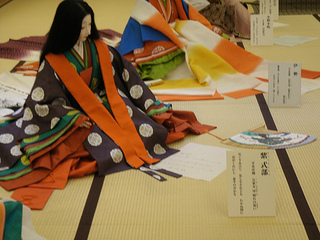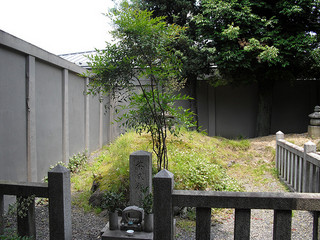Murasaki Shikibu
The Heian period court lady Murasaki Shikibu is famous as the author of the Tale of Genji, and for her poetry.
It is believed she may have been born around 973. Her father was Fujiwara no Tametoki and her mother, a daughter of Fujiwara no Tamenobu. Her true name is unknown, but she is believed to have been known during her life as Fuji-shikibu, as a result of her father holding the post or title of daijô within the Department of Rites (shikibu). It is believed that the name Murasaki Shikibu may have come about after her death, possibly in connection with the Lady Murasaki who appears as a prominent character in her Tale of Genji; Fujiwara no Kintô may have been the first to name the author of the Genji "Murasaki."[1]
Murasaki lost her mother at a young age, and grew up with her scholar & poet father. She learned the Chinese classics faster than her brother Fujiwara no Nobunori, and it's said that her father lamented that she hadn't been born a boy.
Murasaki accompanied her father when he was appointed Echizen no kami in 996, but returned alone to the capital two years later, and very shortly afterwards she married Fujiwara no Nobutaka, a distant relative in his 40s who already had a number of other wives and children. Murasaki gave birth to a daughter of her own, known to us today as Daini no Sanmi, the following year. Nobutaka died suddenly in 1001, and Murasaki took to the life of a widow. It is believed that she began writing the Tale of Genji around this time.
Around 1005, possibly in part because of a recognition of her literary wit, Murasaki was made an attendant to Empress Shôshi (aka Fujiwara no Akiko; daughter of Fujiwara no Michinaga and Imperial consort to Emperor Ichijô). Fearful of attracting too much attention, Murasaki made some efforts to hide her academic knowledge or literary ability, but still gave lectures on various subjects to the empress.
From 1008 to 1010, Murasaki composed Murasaki Shikibu nikki ("Diary of Murasaki Shikibu"); in it, she records her depression despite it being a period of great liveliness and flourishing for Shôshi's inner palace, and includes various comments or criticisms about her fellow ladies-in-waiting. It is believed that The Tale of Genji may have already been circulating and popular among the noblemen of the court.
Through both the Tale of Genji, and her poems included in collections such as the Hyakunin isshu, Murasaki remained a figure of great fame down through the centuries.
References
- "Murasaki Shikibu." Asahi Nihon rekishi jinbutsu jiten 朝日日本歴史人物事典. Asahi Shimbun-sha.
- ↑ Ethan Bushelle, "Afterlife of Murasaki Shikibu: Buddhist Ritual and Canonization of the Tale of Genji," University of California, Santa Barbara, 3 Dec 2015.

